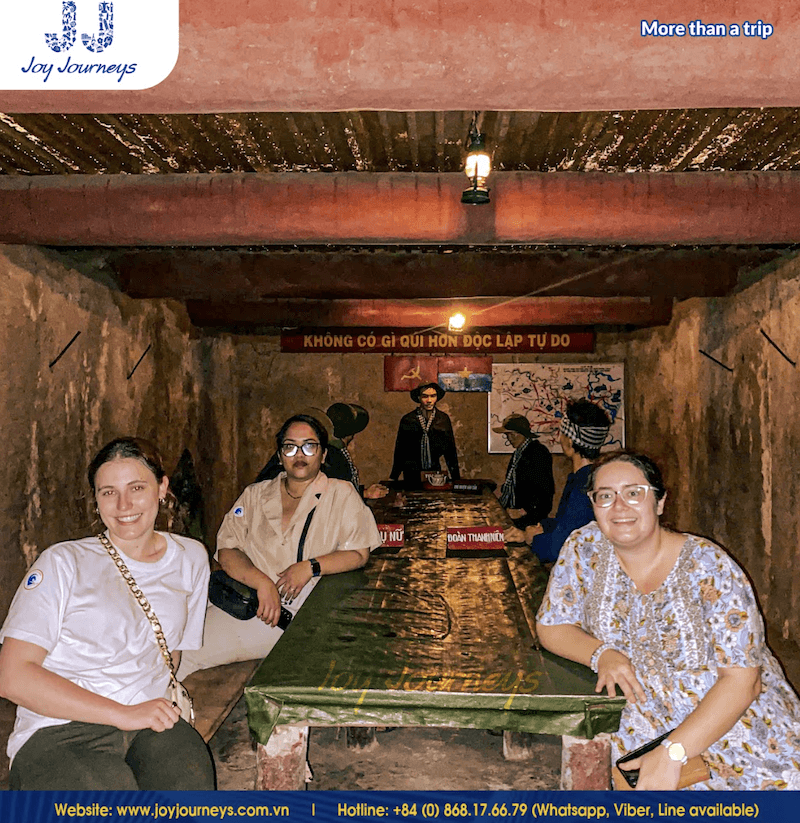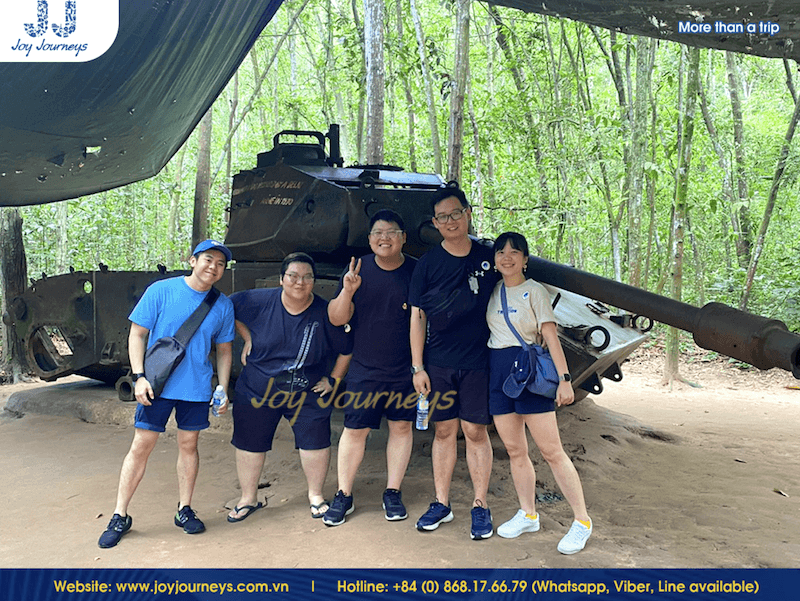The role of Cu Chi tunnels in the Vietnam War represents one of history’s most remarkable examples of asymmetric warfare, where a technologically disadvantaged force effectively countered a superior military power. For military historians and students of warfare, the Cu Chi tunnels Vietnam War connection provides invaluable insights into guerrilla tactics and the power of innovative defensive strategies.
This labyrinthine complex became the backbone of Vietnamese resistance, allowing soldiers to literally disappear underground while maintaining operational capabilities just kilometers from enemy headquarters. The tunnels’ sophisticated design, strategic placement, and versatile functionality transformed what might have been a quick military defeat into a protracted conflict that ultimately favored Vietnamese endurance over American firepower.

Contents
Cu Chi Tunnels Vietnam War: The Hidden Network of Construction and Design
The origins of the Cu Chi tunnel system date back to the late 1940s during the resistance against French colonists. Initially simple and fragmented, they were dramatically expanded during the American conflict, evolving into a sophisticated three-tiered underground city.
The architectural ingenuity of the tunnels is particularly impressive considering they were constructed using only rudimentary tools like hoes and crowbars. Local villagers and Viet Cong fighters dug by hand through the region’s compacted red clay soil, which proved ideal for tunnel construction as it maintained structural integrity without substantial reinforcement. This soil, cemented with natural iron oxide, hardened like concrete during dry seasons, making the tunnels remarkably resistant to bombing.
The network featured three distinct levels:
- The top level (approximately 3 meters deep) for daily operations;
- The middle level (around 6 meters deep) serving as living quarters;
- The deepest level (8-12 meters underground) providing ultimate protection and escape routes.
What made the tunnels particularly effective was their concealment. Entrances were masterfully disguised, often no larger than an A3 paper size and camouflaged with natural materials. These entrances were specifically designed to accommodate the smaller frames of Vietnamese fighters while excluding larger American soldiers, creating an inherent defensive advantage. The system was rigged with elaborate booby traps, including:
- Punji stakes (sharpened bamboo spikes sometimes coated with excrement to cause infection);
- Revolving trap doors concealing spike-lined pits;
- Spring-loaded “clipping armpit” traps;
- “Fish trap” style devices allowing entry but preventing exit.
American forces discovered that locating tunnel entrances was nearly impossible, even after they knew what to look for. Finding the tunnels proved hard though, even after they knew they were looking for them. Every tunnel entrance was concealed, with booby traps leading up to it.

The Role of Cu Chi Tunnels in Strategic Warfare
The Cu Chi tunnels strategy transformed the nature of the conflict, neutralizing many American advantages while maximizing Vietnamese strengths. Their strategic value extended far beyond simple hiding places.
Communication and Supply Lines
The tunnels created secure pathways for Vietnamese fighters to move troops, weapons, and supplies throughout the countryside without detection. This underground transportation system connected villages from the Saigon River to the Cambodian border, allowing for coordinated resistance across a wide area.
During the Vietnam War, the network had been expanded into an assembly complex for Communist guerrilla soldiers to house troops, transport communications, and supplies, receive medical treatments, take shelters from aerial bombardment, and mount surprise attacks, after which they could disappear underneath the ground.
This connectivity was crucial for maintaining supply lines despite American air superiority. The Viet Cong “leveraged on the nearby Mekong River to transport supplies, troops and vehicles between strategic locations,” creating a resilient logistical network that American forces struggled to disrupt.
Cu Chi Tunnels Strategy: Guerilla Warfare Tactics in Vietnam War History
How were the Cu Chi tunnels used in the war to greatest effect? Perhaps their most significant function was facilitating guerrilla warfare. The tunnels enabled a “strike and disappear” strategy that frustrated American forces. Vietnamese fighters could emerge from hidden entrances to attack American or South Vietnamese positions, then vanish underground before the enemy could effectively respond.
The search results reveal that these tactics extended even to American bases. Soon after setting up the Cu Chi Base Camp, US personnel began noticing damaged helicopter motors, stolen food, and even soldiers being killed in their cots. Saboteurs managed to wreck Chinooks and harm service members without even breaching the perimeter. Turns out, the entire base was undermined by tunnels and trap doors.
This infiltration capability meant American forces were never truly secure, even within their own bases. The psychological impact of this vulnerability cannot be overstated, creating a constant sense of danger and unease among American troops.

Importance of Cu Chi Tunnels in Vietnam War: Shelter and Protection
Another critical importance of Cu Chi tunnels in Vietnam War was providing protection against America’s overwhelming firepower. The underground network sheltered fighters and civilians alike from bombing campaigns, artillery, and chemical warfare.
The tunnels were constructed to withstand extreme bombardment. They were “bomb-resistant and could withstand the weight of tanks and armoured vehicles.” This resilience allowed Vietnamese forces to survive intense bombing campaigns that might otherwise have decimated their fighting capacity.
Within these subterranean sanctuaries, the Vietnamese created complete communities featuring hospitals, kitchens with innovative smokeless “Hoang Cam” stoves, and even educational and cultural facilities. Hospitals and schools were also built into these tunnels, highlighting how the network supported not just military operations but community survival.
Challenges for Opposing Forces
American soldiers Cu Chi tunnels encounters represented one of the most frustrating and psychologically taxing aspects of the war. Despite technological superiority, U.S. forces found themselves at a severe disadvantage when confronting this unconventional defensive system.
Locating and Penetrating the Tunnels
American forces employed numerous techniques to detect tunnel entrances, including trained dogs and meticulous ground searches. However, the Vietnamese countered these methods effectively using Viet Cong tactics, such as sprinkling pepper around entrances to confuse detection dogs and masterfully camouflaging access points.
Even when tunnels were discovered, exploration proved extremely dangerous. Special “tunnel rat” soldiers-typically smaller men who could fit through the narrow passages-were trained for this hazardous duty. The soldiers would spend hours navigating the cramped, dark, foul-smelling tunnels with certain death lurking around each bend. One wrong turn and they could fall into a booby trap pit for a long and painful death or face the continual threat of grenades rolling towards them.
American forces attempted to neutralize tunnels through various means, including:
- Pumping tear gas and other chemicals into entrances;
- Flooding tunnel sections;
- Using explosives to collapse passages;
- Deploying specially trained “tunnel rat” soldiers.
These efforts met with limited success. The Cu Chi tunnels military tactics included specific countermeasures: watertight doors prevented flooding, the triangular design allowed escape if one entrance was compromised, and the iron oxide in the soil made tunnels resistant to explosives.

Psychological Impact on American Soldiers Cu Chi Tunnels
The tunnel warfare represented by Cu Chi created profound psychological challenges for American forces. The constant threat of booby traps, the inability to see the enemy, and the knowledge that danger could literally emerge from beneath their feet created immense stress.
American troops attempted to deny tunnels by filling them “with riot control agents like a powdered form of tear gas while collapsing the entrances with explosives.” Despite these efforts, the psychological advantage remained with the Vietnamese forces, who knew the terrain intimately and operated from positions of relative security.
Military Operations Targeting the Tunnels
The American military launched several major operations specifically targeting the Cu Chi tunnel network:
Operation Crimp (January 1966): B-52 bombers dropped 30-ton loads of explosives, followed by 8,000 soldiers searching for enemy activity. The operation had limited success, as Vietnamese fighters quickly retreated into tunnels. The bombing operation began in early January, 1966, when B-52 bombers dropped 30-ton loads of high explosives onto the Cu Chi and the Iron Triangle areas. The natural iron oxide in the soil cemented tunnel linings and made them stable, resilient and hard to destroy.”
Operation Cedar Falls (January 1967): This larger operation deployed 30,000 American troops to attack the tunnel complexes. Despite massive resources, they failed to discover the Viet Cong Military Regional IV Headquarters or permanently neutralize the tunnel threat. The North Vietnamese troops slipped back into the Iron Triangle area a few months after the tunnels were cleared. These tunnels gave them a strategic advantage during the Tet Offensive in the 1968 assault on Saigon.
These major operations demonstrated the resilience of the tunnel system against even the most concentrated American military efforts.

Cu Chi Tunnels Military Tactics: Impact on the Vietnam War
The Cu Chi tunnels and Tet Offensive connection represents perhaps the clearest example of how this underground network influenced the war’s trajectory. The tunnels served as launching points for portions of the 1968 Tet Offensive, a coordinated series of surprise attacks throughout South Vietnam that shocked American forces and the American public.
The tunnels allowed Vietnamese forces to maintain a presence virtually on the doorstep of Saigon and the main U.S. military headquarters. This proximity enabled them to gather intelligence, plan operations, and position forces without detection, contributing significantly to the offensive’s effectiveness.
Beyond specific battles, the tunnels played a crucial role in prolonging the conflict. By neutralizing American advantages in firepower and mobility, they forced a protracted war that increasingly drained American resources and public support. The tunnels epitomized the asymmetric strategy that ultimately proved successful against a technologically superior opponent.
They leveraged on the nearby Mekong River to transport supplies, troops and vehicles between strategic locations. Throughout the Vietnam War, the tunnel network proved to be an asset to the Viet Cong. They dragged the war longer, and costlier, than what the US troops had expected.
>> View Details and Pricing: 4 Best Cu Chi Tunnels Tour: Less Crowded & Budget-Friendly
Legacy of the Cu Chi Tunnels
Today, the Cu Chi tunnels stand as powerful historical monuments and popular tourist attractions. Two main sites-Ben Dinh and Ben Duoc-offer visitors glimpses into this remarkable underground world, with sections widened and reinforced for tourist access.
The historical significance of the tunnels has been formally recognized. The Cu Chi Tunnels stand as a powerful testament to the resilience, ingenuity and determination of the Vietnamese people during decades of wartime resistance.” In 2015, they were honored with the title of “Hero of Labor” and designated as a special national historical site in 2016.
For military historians and strategists, the tunnels provide valuable lessons in asymmetric warfare and the importance of adaptation. They demonstrate how determination, ingenuity, and intimate knowledge of terrain can overcome seemingly insurmountable technological and material disadvantages.
The human cost of the tunnels was immense. Around 45,000 Vietnamese men and women died defending the Cu Chi tunnels over the course of the Vietnam War.” This sacrifice underscores the tunnels’ significance in Vietnamese history and national identity.

FAQs
How effective were the Cu Chi Tunnels in the war?
The role of Cu Chi Tunnels was remarkably effective, enabling Vietnamese forces to survive intense bombardment, launch surprise attacks, gather intelligence, and maintain supply lines despite American technological superiority. They allowed fighters to operate within striking distance of Saigon and contributed significantly to the Tet Offensive. Perhaps most importantly, they helped extend the conflict, increasing the costs for American forces and ultimately contributing to the U.S. withdrawal in 1973.
Did the Americans ever capture the Cu Chi Tunnels?
While American forces discovered and explored sections of the tunnels during operations like Crimp and Cedar Falls, they never completely captured or neutralized the entire network. The extensive size (over 250 kilometers), complex design, effective concealment, and booby traps made complete capture virtually impossible. Even when sections were discovered, Vietnamese forces often returned after American troops departed, reconstructing damaged portions and continuing operations.
How did the tunnels affect the outcome of the Vietnam War?
The tunnels contributed significantly to the war’s outcome by enabling Vietnamese forces to withstand American military power while inflicting steady casualties. They facilitated the Tet Offensive, which, though a tactical defeat for Vietnamese forces, represented a strategic victory by shocking the American public and undermining support for the war. By helping to prolong the conflict, the tunnels contributed to the growing political pressure that eventually led to American withdrawal.
What can we learn from the Cu Chi Tunnels today?
The Cu Chi Tunnels offer enduring lessons about asymmetric warfare, demonstrating how determination, innovative tactics, and intimate knowledge of terrain can offset material disadvantages. They highlight the limitations of technological superiority when confronting a determined adversary using unconventional tactics. For military planners, they underscore the importance of understanding cultural and geographical factors in conflict. More broadly, they stand as a testament to human ingenuity and resilience in the face of overwhelming odds.
Discover the vital role of Cu Chi Tunnels in Vietnam’s wartime history – an underground stronghold that shaped resistance strategies and showcased extraordinary human resilience. To truly grasp their impact, book a guided tour with Joy Journeys for expert insight and immersive exploration. Visit joyjourneys.com.vn or call +84 (0) 868.17.66.79 to plan your meaningful visit today.



Related Posts
Saigon’s “Flower Market Replica”: Where To Find Them
Ho Chi Minh City’s floral charm is not limited to its bustling wholesale markets. Imagine wandering through a place where vibrant petals, fragrant blooms, and the spirit of traditional Vietnamese markets come alive—without the overwhelming crowds. A flower market replica captures that magic, blending the beauty of fresh flowers with the charm of a curated, […]
Is it Safe to Travel to Vietnam Right Now? A Complete 2025 Guide
Vietnam has emerged as one of Southeast Asia’s most captivating destinations, drawing millions of visitors annually with its rich culture, stunning landscapes, and incredible cuisine. However, many travelers still ask: Is it safe to travel to Vietnam right now? This comprehensive guide provides you with everything you need to know about Vietnam travel safety in […]
Ho Chi Minh Cu Chi Tunnels Tour: The Ultimate Guide
The Cu Chi Tunnels stand as one of Vietnam’s most remarkable historical sites, offering visitors a profound glimpse into the ingenuity and resilience displayed during the Vietnam War. For travelers, a Ho Chi Minh Cu Chi tunnels tour represents an essential experience that combines education, adventure, and deep cultural understanding. This comprehensive guide will help […]